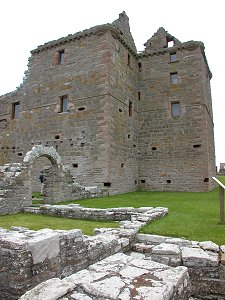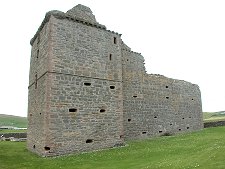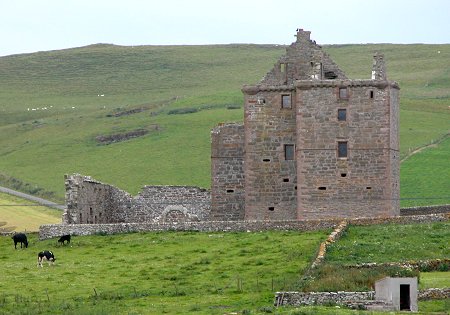 Noltland Castle from the East |
On rising ground half a mile west of Westray's best natural harbour at the Bay of Pierowall is one of Scotland's most unusual castles.
In 1560, during the chaos of the Reformation, parts of Westray were granted by the Bishop of Orkney, Adam Bothwell, to his brother-in-law, Gilbert Balfour. Balfour was also made Sheriff of Orkney and decided to secure his position by building Noltland Castle. Balfour was a man whose approach to politics earned him many mortal enemies and his castle was intended to cover all eventualities.
In effect the design brief was for two floors of grand mansion placed on top of two floors of heavily defended fortress. The lower floors are remarkable for being pierced by no fewer than 71 gunloops, designed to ensure that every approach to the castle would be covered.
The layout is best thought of as an extended Z-plan castle. The main block measures some 26m by 11m, and is oriented with its long axis east to west. At the north-east and south-west corners are square towers each some 8m by 8m.
In February 1567 Balfour was implicated in the successful plot to kill Mary Queen of Scots' second husband, Lord Darnley, in Edinburgh. Amongst his co-conspirators was James, Earl of Bothwell whose marriage to Mary three months later led directly to her abdication. Balfour's loyalty to Bothwell did not extend to giving him sanctuary when Bothwell turned up on Westray while fleeing to Denmark. This suggests that enough of the castle was habitable by then for there to be a door for Balfour to shut in Bothwell's face.
Balfour's support for Mary's claim to the Scottish throne over that of her son, James VI left him increasingly exposed. As a result Balfour had to flee Orkney for Sweden in 1572 and Noltland Castle was taken by Robert Stewart, later to become Earl of Orkney, for James VI. The Balfour family regained possession of the castle in 1574, but Gilbert Balfour remained in Sweden until his habitual plotting placed him fatally on the wrong side of the King of Sweden in 1576.
The Balfours remained at Noltland until the castle was besieged and taken by forces working on behalf of Patrick Stewart, the deeply unloved 2nd Earl of Orkney, in 1598. It was probably back in Balfour hands by 1606, when it was sold by them to Sir John Arnot, who in 1611 became Sheriff of Orkney after Patrick Stewart had been imprisoned for treason.
In the 1600s a range of buildings was erected enclosing a courtyard to the south of the castle. These at least were still habitable when mentioned in a marriage contract in 1761. But it seems likely that the main part of the castle was already in decline by the time the courtyard was built.
What is more clear is that Noltland Castle was never finished, and what is on view today was the work of different hands at different times. The north-east tower was raised to its full four storeys to provide accommodation for the lord and his family, as was the east end of the main block.
But the west end of the main block of the castle and the south-west tower were only ever built to second floor level. Indeed, it seems doubtful whether the great hall (or at least the full length of it) ever looked much more complete than it does today, open to the sky.
At some point the south-west tower was converted to provide a grand spiral staircase up to the hall level, complete with a large stone cap to the newel-post that would originally have continued upwards to form a cone. But by far the most impressive space in the castle today are the kitchens, which would originally have comprised two floors and also been the main fighting space of the castle in times of conflict.
Noltland Castle is a fascinating reminder of a world gone by; a remarkably well preserved example of a castle; and above all a slightly sad place: it's not often you find somewhere so caught up in the vicious politics of the day that its demise overtook its completion.

|
|
|
Visitor InformationView Location on MapGrid Ref: HY 429 488. www.historicenvironment.scot HES: Castle Web Page What3Words Location: ///disbelief.copy.notion |
 Tower House Interior |
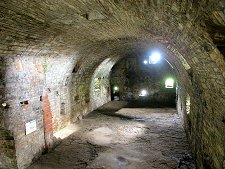 The Kitchens |
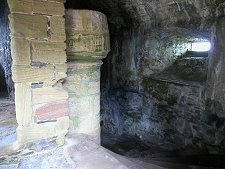 Main Spiral Stair Top |
 Masons' Marks |
